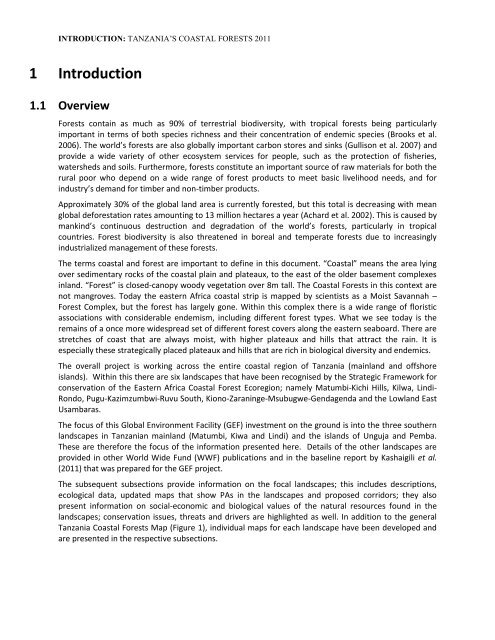Neil D. Burgess, Paul Harrison, Peter Sumbi, James Laizer, Adam ...
Neil D. Burgess, Paul Harrison, Peter Sumbi, James Laizer, Adam ...
Neil D. Burgess, Paul Harrison, Peter Sumbi, James Laizer, Adam ...
You also want an ePaper? Increase the reach of your titles
YUMPU automatically turns print PDFs into web optimized ePapers that Google loves.
INTRODUCTION: TANZANIA’S COASTAL FORESTS 2011<br />
1 Introduction<br />
1.1 Overview<br />
Forests contain as much as 90% of terrestrial biodiversity, with tropical forests being particularly<br />
important in terms of both species richness and their concentration of endemic species (Brooks et al.<br />
2006). The world’s forests are also globally important carbon stores and sinks (Gullison et al. 2007) and<br />
provide a wide variety of other ecosystem services for people, such as the protection of fisheries,<br />
watersheds and soils. Furthermore, forests constitute an important source of raw materials for both the<br />
rural poor who depend on a wide range of forest products to meet basic livelihood needs, and for<br />
industry’s demand for timber and non-timber products.<br />
Approximately 30% of the global land area is currently forested, but this total is decreasing with mean<br />
global deforestation rates amounting to 13 million hectares a year (Achard et al. 2002). This is caused by<br />
mankind’s continuous destruction and degradation of the world’s forests, particularly in tropical<br />
countries. Forest biodiversity is also threatened in boreal and temperate forests due to increasingly<br />
industrialized management of these forests.<br />
The terms coastal and forest are important to define in this document. “Coastal” means the area lying<br />
over sedimentary rocks of the coastal plain and plateaux, to the east of the older basement complexes<br />
inland. “Forest” is closed-canopy woody vegetation over 8m tall. The Coastal Forests in this context are<br />
not mangroves. Today the eastern Africa coastal strip is mapped by scientists as a Moist Savannah –<br />
Forest Complex, but the forest has largely gone. Within this complex there is a wide range of floristic<br />
associations with considerable endemism, including different forest types. What we see today is the<br />
remains of a once more widespread set of different forest covers along the eastern seaboard. There are<br />
stretches of coast that are always moist, with higher plateaux and hills that attract the rain. It is<br />
especially these strategically placed plateaux and hills that are rich in biological diversity and endemics.<br />
The overall project is working across the entire coastal region of Tanzania (mainland and offshore<br />
islands). Within this there are six landscapes that have been recognised by the Strategic Framework for<br />
conservation of the Eastern Africa Coastal Forest Ecoregion; namely Matumbi-Kichi Hills, Kilwa, Lindi-<br />
Rondo, Pugu-Kazimzumbwi-Ruvu South, Kiono-Zaraninge-Msubugwe-Gendagenda and the Lowland East<br />
Usambaras.<br />
The focus of this Global Environment Facility (GEF) investment on the ground is into the three southern<br />
landscapes in Tanzanian mainland (Matumbi, Kiwa and Lindi) and the islands of Unguja and Pemba.<br />
These are therefore the focus of the information presented here. Details of the other landscapes are<br />
provided in other World Wide Fund (WWF) publications and in the baseline report by Kashaigili et al.<br />
(2011) that was prepared for the GEF project.<br />
The subsequent subsections provide information on the focal landscapes; this includes descriptions,<br />
ecological data, updated maps that show PAs in the landscapes and proposed corridors; they also<br />
present information on social-economic and biological values of the natural resources found in the<br />
landscapes; conservation issues, threats and drivers are highlighted as well. In addition to the general<br />
Tanzania Coastal Forests Map (Figure 1), individual maps for each landscape have been developed and<br />
are presented in the respective subsections.

















